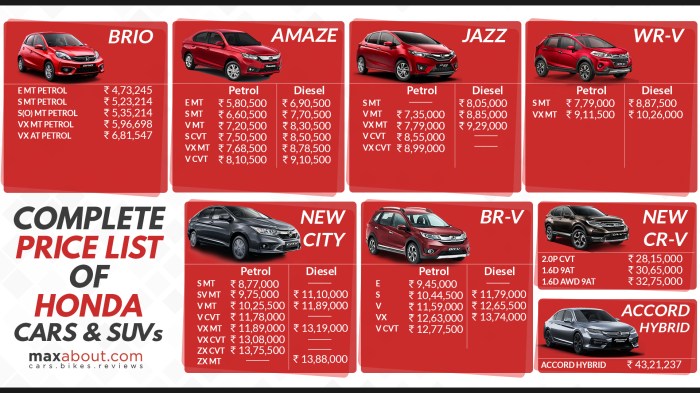All New Car Price List A Comprehensive Guide
Understanding the “All New Car Price List” Search Intent
The search phrase “all new car price list” reveals a user’s intention to gather comprehensive pricing information for newly released vehicles. This intent can stem from various motivations and target different buyer profiles.
Motivations Behind the Search
Users searching for an “all new car price list” are typically driven by a need for comparative shopping. This could involve researching various models and brands to make an informed decision, comparing prices across dealerships, or simply exploring the market to understand current pricing trends. The search reflects a proactive approach to car buying, indicating a level of seriousness in the purchase process.
Buyer Personas, All new car price list
This search query attracts a diverse range of car buyers. First-time buyers often utilize such lists to navigate the complexities of the market and understand the range of available options within their budget. Luxury car buyers might use the list to compare high-end models and identify the best value for their investment. Budget-conscious buyers rely on these lists to identify the most affordable options that meet their needs.
Finally, seasoned car buyers may use the list to quickly assess market changes and potential deals.
Geographic Variations
The geographic context significantly impacts the search intent. Local searches, often including city or region specifics, indicate a user looking for dealerships or prices within their immediate vicinity. National searches, on the other hand, suggest a broader search encompassing the entire country, potentially indicating a willingness to travel for the best deal or considering options from various regions.
User Intents and Needs
| Intent | Buyer Type | Geographic Focus | Information Required |
|---|---|---|---|
| Compare prices of similar models | Budget-conscious buyer | Local | MSRP, dealer markups, available incentives |
| Explore luxury car options | Luxury car buyer | National | MSRP, features, reviews, dealer locations |
| Find the best deal on a specific model | First-time buyer | Local | Prices from multiple dealerships, financing options |
| Track market trends | Seasoned buyer | National | Historical price data, sales figures, future projections |
Data Sources for New Car Prices
Maintaining an accurate and up-to-date “all new car price list” requires access to reliable data sources. The accuracy and completeness of data vary significantly across these sources, demanding a multi-source approach to ensure comprehensive and dependable information.
Reliable Data Sources

Source: truckscout24.com
Manufacturer websites are a primary source, providing official MSRP (Manufacturer’s Suggested Retail Price) data. Automotive news sites often compile pricing information from various sources, offering a broader perspective. Price comparison websites aggregate data from multiple dealerships and manufacturers, aiming to provide a comprehensive overview. However, each source has its limitations in terms of accuracy and timeliness.
Accuracy and Completeness
Manufacturer websites typically offer the most accurate MSRP, but may lack information on dealer markups or regional pricing variations. Automotive news sites often provide a good overview but might lag behind in updating the latest prices. Price comparison websites strive for comprehensiveness but may face challenges in ensuring data accuracy across all listed dealerships.
Challenges of Maintaining Accuracy
Fluctuating market conditions, including changes in demand, supply chain disruptions, and currency fluctuations, significantly impact new car prices. Dealer markups vary widely depending on location, model popularity, and inventory levels, making it challenging to provide a consistently accurate price list. Regular updates are crucial to reflect these dynamic changes.
Workflow for Data Updates
A robust workflow involves automated data scraping from manufacturer websites, automotive news sites, and price comparison platforms. Data validation and reconciliation steps are essential to identify and address inconsistencies across sources. A centralized database, regularly updated and managed, is crucial for maintaining accuracy. Finally, human review and quality control are important to ensure data reliability and identify any outliers or errors.
Presenting the Information Effectively
Effective presentation is crucial for users to easily compare prices and make informed decisions. Interactive elements, clear organization, and visual aids significantly enhance the user experience and facilitate meaningful comparisons.
Effective Presentation Methods
Interactive tables allow users to sort and filter data based on various criteria (make, model, price range, etc.). Sortable lists provide a clear and concise view of the data, allowing for easy comparison. Filterable data enables users to refine their search based on specific requirements, focusing on relevant results.
Organizing Information for Comparison
Organizing the data by make, model, and trim level allows for easy comparison within the same vehicle line. Grouping cars by class (e.g., sedan, SUV, truck) helps users quickly compare similar vehicle types. Presenting price ranges alongside MSRP helps provide a more realistic picture of potential costs.
Understanding all new car price lists is crucial for budgeting, but the initial investment can be substantial. For a more budget-friendly option, consider exploring the used car market; you can find competitive deals by checking out the current second hand car price in new zealand listings. Ultimately, comparing both new and used car prices helps you make an informed decision that aligns with your financial plan.
Visual Elements for Insights

Source: maxabout.us
Charts and graphs can effectively visualize price trends over time, highlighting price fluctuations and seasonal variations. Bar charts can compare prices across different models or brands, facilitating quick comparisons. Scatter plots can illustrate the relationship between price and features.
Sample New Car Price Table
| Make | Model | Year | Trim | MSRP | Average Dealer Markup |
|---|---|---|---|---|---|
| Toyota | Camry | 2024 | LE | $26,000 | $500 |
| Honda | Civic | 2024 | LX | $23,000 | $300 |
| Ford | Escape | 2024 | SE | $28,000 | $700 |
Factors Influencing New Car Prices
Numerous factors interact to determine the final price of a new car. Understanding these influences helps consumers make informed decisions and anticipate potential price variations.
Key Price Influencers
- Manufacturing Costs: Raw materials, labor, and manufacturing processes directly impact production costs, influencing the base price.
- Market Demand: High demand for specific models can lead to increased prices, while low demand may result in discounts or incentives.
- Fuel Efficiency Standards: Meeting stricter fuel economy regulations often necessitates investments in technology, potentially increasing manufacturing costs and the final price.
- Currency Fluctuations: Changes in currency exchange rates affect the cost of imported parts and materials, influencing the final price of vehicles.
- Technological Advancements: Advanced safety features, infotainment systems, and driver-assistance technologies add to the manufacturing cost and subsequently the vehicle’s price.
- Government Regulations and Taxes: Taxes, tariffs, and environmental regulations contribute to the overall cost of the vehicle.
Beyond the MSRP: Additional Costs
The MSRP is only a starting point. Several additional costs must be considered when budgeting for a new car purchase. Understanding these hidden costs ensures a realistic assessment of the total cost of ownership.
Additional Costs
- Taxes: Sales tax, excise tax, and other regional taxes vary by location and add to the final price.
- Fees: Dealer fees, documentation fees, and other processing fees are commonly added to the purchase price.
- Registration: Vehicle registration fees are required to legally operate the vehicle.
- Insurance: Car insurance premiums vary based on factors such as the vehicle’s value, driver profile, and coverage level.
- Financing: Interest charges on auto loans significantly increase the total cost of ownership over the loan term.
- Extended Warranties: Optional extended warranties provide additional coverage beyond the manufacturer’s warranty but increase the initial cost.
- Accessories and Add-ons: Optional accessories, such as upgraded sound systems or specialized packages, can significantly inflate the price.
FAQ Guide: All New Car Price List
What is the difference between MSRP and the out-the-door price?
MSRP is the manufacturer’s suggested retail price. The out-the-door price includes all additional costs like taxes, fees, and dealer markups.
How can I find the average dealer markup for a specific car model?
Online resources and automotive news sites often report average dealer markups, though these can vary by region and dealership.
What financing options are available for new car purchases?
Options include loans from banks, credit unions, and dealerships. Consider interest rates, loan terms, and overall cost before choosing a financing plan.
Are there any resources to help me negotiate the price of a new car?
Numerous websites and consumer guides offer advice on negotiating car prices, focusing on research, preparation, and effective communication with dealerships.




















